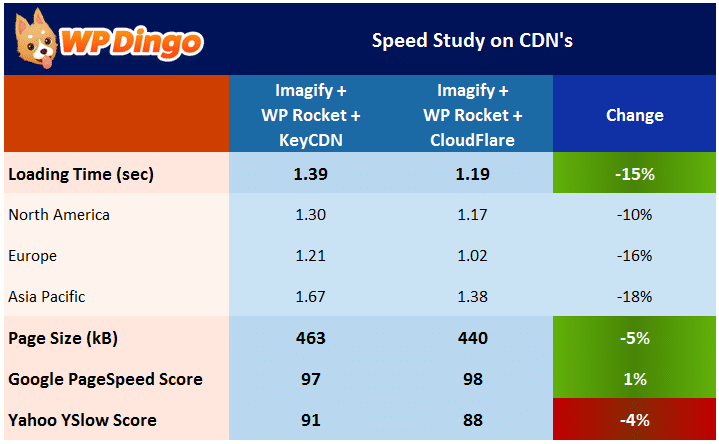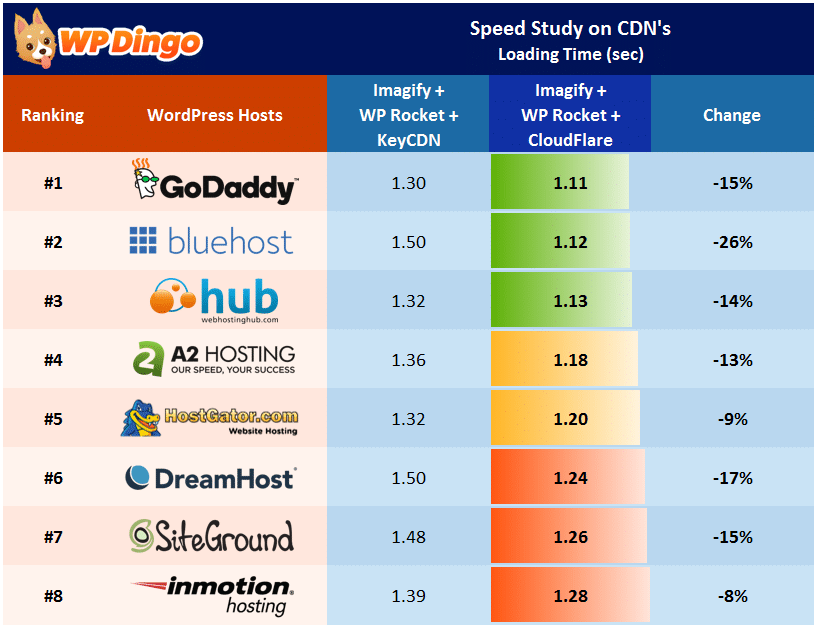The Speed Study Goal
My goal with conducting these Speed Studies is to find out which strategies are the best at improving our site speed.
I’ll implement each strategy using the following approach:
- Setup the strategy on all 8 of our live test sites
- Then for the following 4 weeks, gather the load times from our Desktop Speed Test using GTmetrix
- Measure the impact of each strategy by comparing the average speed before and after
- Ultimately decide whether the strategy works?
Speed Study #5: CloudFlare
With the success of KeyCDN in Speed Study 4, let’s turn our focus onto setting up a CDN with CloudFlare.
The theory here is that by using a CDN (Content Delivery Network) your site’s content can be loaded from multiple locations around the world, rather than just 1. When someone visits the site, the CDN will direct them to the closest location, which results in the site loading quicker. What we’re interested in is how much of an impact this will have and is it worth the cost and effort in setting it up?
To perform this study, I will install CloudFlare on our 8 sites, then apply the same settings. To see what steps were followed, check out How to Setup CloudFlare.

All Setup
I have now followed this process on all 8 of our Live Test Sites.
Next up is 4 weeks of testing – I can’t wait to find out what sort of an impact CloudFlare will have. I will once again be especially keen to see the results from Europe and Asia Pacific, which proved to be the largest improvement with KeyCDN on board. Will the same happen with CloudFlare, time will tell…
The Results – 30th October 2016
After 4 weeks of testing, lets take a look at how much of an impact installing CloudFlare has had on our 8 hosts. In the table below, I’m comparing the average of the 4 weeks prior when KeyCDN was setup, with the 4 weeks after with CloudFlare:

Conclusion
So before we get into the details, let’s first remember the previous Speed Study results:
- Imagify achieved a 14% improvement in Speed Study 1
- W3 Total Cache achieved a massive 37% speed improvement in Speed Study 2
- WP Rocket improved our load times by 3% in Speed Study 3
- Then KeyCDN achieved a further speed improvement of 25% in Speed Study 4
So how did CloudFlare go? The good news is the trend of improvements continued, with CloudFlare achieving a further 15% improvement!!
When it comes to making a call on whether CloudFlare is worth installing, I would clearly say YES for the following reasons:
- There’s a further 15% improvement in load time
- A 5% drop in Page Size to help reduce hosting / CDN bandwidth
- And once it’s initially setup, there’s no ongoing effort required 🙂
- Speeds were improved across all 3 locations: North America, Europe & Asia Pacific
Individual Host Performance
Let’s now take a look at how our individual hosts performed:

Major Observations
- All of our 8 hosts enjoyed an improvement thanks to CloudFlare, ranging from 8% to 26%.
- The most noticeable speed improvement occurred with Bluehost, jumping from 7th into 2nd place.
- Congratulations to GoDaddy who have just hung onto the prized #1 Ranking!!
- The overall observation from where I sit is that CloudFlare has performed tremendously well, especially considering it is a free CDN solution!!
What’s Next?
With CloudFlare proving to be so successful, let’s now see how it will perform if we use W3 Total Cache instead of WP Rocket. Speed Study #6 will focus on what speed improvement is possible with CloudFlare + W3 Total Cache?








 Hi, I'm Clint!
Hi, I'm Clint!






